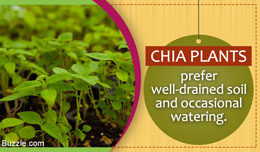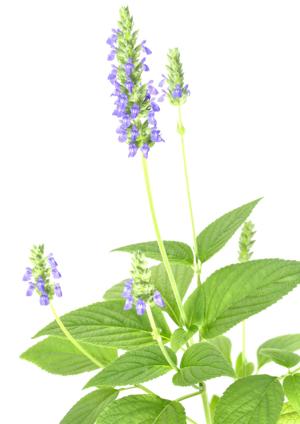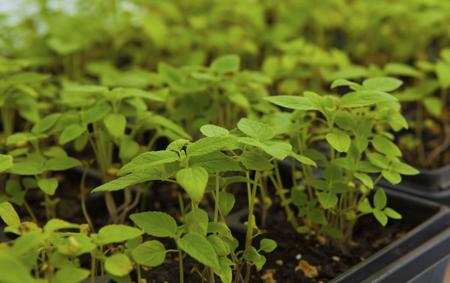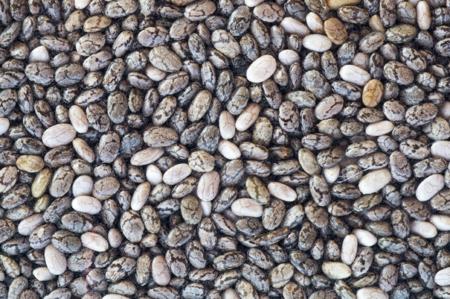





 Did You Know?If you are raising animals on your farm, planting chia can be beneficial in several ways. Studies conducted in Canada show that chia seeds, when added to animal food, help reduce the saturated fatty acid (SFA) content of the white and dark meats. Another study conducted in the U.S. suggests that feeding hens with chia seeds can help lower the saturated fatty acid content in the egg yolk.Chia, native to south-west America, has been highly valued as a nutrient-dense staple food for hundreds of years. Chia was grown by the Aztecs and other indigenous people of Mexico and America. Tiny chia seeds are prized for being high in essential fatty acids, fiber, protein, vitamins, and minerals. They come with a nutty flavor and can be consumed raw. The therapeutic tea made from fresh or dried chia leaves is used to treat various conditions. The seeds are known as 'energy food' and are included in the list of superfoods by dietitians all over the world. Instead of buying sprouted chia seeds from a health store, you can plant some chia seedlings in your garden, and within a few months, you can have a jar full of chia seeds. If you have surplus seeds, you can add them to the animal or bird feed.
Did You Know?If you are raising animals on your farm, planting chia can be beneficial in several ways. Studies conducted in Canada show that chia seeds, when added to animal food, help reduce the saturated fatty acid (SFA) content of the white and dark meats. Another study conducted in the U.S. suggests that feeding hens with chia seeds can help lower the saturated fatty acid content in the egg yolk.Chia, native to south-west America, has been highly valued as a nutrient-dense staple food for hundreds of years. Chia was grown by the Aztecs and other indigenous people of Mexico and America. Tiny chia seeds are prized for being high in essential fatty acids, fiber, protein, vitamins, and minerals. They come with a nutty flavor and can be consumed raw. The therapeutic tea made from fresh or dried chia leaves is used to treat various conditions. The seeds are known as 'energy food' and are included in the list of superfoods by dietitians all over the world. Instead of buying sprouted chia seeds from a health store, you can plant some chia seedlings in your garden, and within a few months, you can have a jar full of chia seeds. If you have surplus seeds, you can add them to the animal or bird feed. The botanical name of chia plant is Salvia hispanica, and it belongs to the mint family, Lamiaceae. A small chia plant looks like a common mint plant. However, it is an annual flowering herb and can grow up to 1.75 m (5.7 ft) tall. It has thick, dark green, wrinkled, 'opposite leaves' which can be 4-8 cm (1.6-3.1 in) long and 3-5 cm (1.2-2.0 in) wide. The upper surfaces of leaves are covered with fine, soft, grayish hair. The spike at the end of each stem produces white or purple flowers in several clusters.Planting
The botanical name of chia plant is Salvia hispanica, and it belongs to the mint family, Lamiaceae. A small chia plant looks like a common mint plant. However, it is an annual flowering herb and can grow up to 1.75 m (5.7 ft) tall. It has thick, dark green, wrinkled, 'opposite leaves' which can be 4-8 cm (1.6-3.1 in) long and 3-5 cm (1.2-2.0 in) wide. The upper surfaces of leaves are covered with fine, soft, grayish hair. The spike at the end of each stem produces white or purple flowers in several clusters.Planting You can plant the seeds outdoors in April or May, or you may plant them indoors in March or April. Get a good planting mix or use a homemade combination of equal portions of compost, garden loam, and sand. You may ruffle the selected area lightly with a rake, or loosen the soil with your fingers. Just scatter the seeds over the soil and rake lightly. About 1/4 cup of chia seeds can be sprinkled over one square foot area. You can thin the plants afterward. There is no need of digging a hole to sow them. Gently press the soil surface and see to it that the seeds are covered by the soil. You may sow the seeds in a tray or a pot in your kitchen, and may later transfer the seedlings to a sunny spot outdoors. You can transplant them when they are about three inches tall. While replanting, leave some space between two plants (plant them 12 to 18 inches apart), as they grow quite tall.Basic NeedsYou can keep the seeds in a low-light area until they germinate, but they would need ample light as they start growing. They need well-drained, sandy or loamy soil to grow. Lightly sprinkle remnants of burned plants (charate) over the seedbed. This will help increase germination. Studies show that being a 'fire following plant', chia crop increases in abundance after a fire. These plants don't tolerate frost.WeedingChia plants won't grow well with weeds. Remove the weeds growing in your garden.PruningRemove dead flowers to encourage continued blooming until frost.WateringUsing a fine spray nozzle, lightly water the seedbeds every day so that the soil remains moist. Within a week or so, you will be able to see the sprouts and tiny leaves emerging from the soil. Even if you are growing the seeds in a pot, sprinkle them lightly, and water them regularly. Once established, there is no need of watering them daily. The soil can be moist, but not wet. The plant doesn't need too much water and seems to do better if it's kept on the dry side. Avoid planting chia near lawns and other plants that require frequent watering.FertilizationYou can grow chia organically, without using harmful pesticides and chemicals. Mulch the plants regularly. The shrub can tolerate arid conditions as well as soils of low fertility.Harvesting the Seeds
You can plant the seeds outdoors in April or May, or you may plant them indoors in March or April. Get a good planting mix or use a homemade combination of equal portions of compost, garden loam, and sand. You may ruffle the selected area lightly with a rake, or loosen the soil with your fingers. Just scatter the seeds over the soil and rake lightly. About 1/4 cup of chia seeds can be sprinkled over one square foot area. You can thin the plants afterward. There is no need of digging a hole to sow them. Gently press the soil surface and see to it that the seeds are covered by the soil. You may sow the seeds in a tray or a pot in your kitchen, and may later transfer the seedlings to a sunny spot outdoors. You can transplant them when they are about three inches tall. While replanting, leave some space between two plants (plant them 12 to 18 inches apart), as they grow quite tall.Basic NeedsYou can keep the seeds in a low-light area until they germinate, but they would need ample light as they start growing. They need well-drained, sandy or loamy soil to grow. Lightly sprinkle remnants of burned plants (charate) over the seedbed. This will help increase germination. Studies show that being a 'fire following plant', chia crop increases in abundance after a fire. These plants don't tolerate frost.WeedingChia plants won't grow well with weeds. Remove the weeds growing in your garden.PruningRemove dead flowers to encourage continued blooming until frost.WateringUsing a fine spray nozzle, lightly water the seedbeds every day so that the soil remains moist. Within a week or so, you will be able to see the sprouts and tiny leaves emerging from the soil. Even if you are growing the seeds in a pot, sprinkle them lightly, and water them regularly. Once established, there is no need of watering them daily. The soil can be moist, but not wet. The plant doesn't need too much water and seems to do better if it's kept on the dry side. Avoid planting chia near lawns and other plants that require frequent watering.FertilizationYou can grow chia organically, without using harmful pesticides and chemicals. Mulch the plants regularly. The shrub can tolerate arid conditions as well as soils of low fertility.Harvesting the Seeds Chia seed head looks like a wheat seed head. Small flower clusters develop in July or August. You can collect the flowers in a paper bag and allow them to sun dry. Then you can remove the seeds. Or when the blossoms dry or turn yellow, you may harvest chia seeds. You may pull out the whole plant, and beat the stalks over a container to collect the tiny seeds. Before pulling out the plant, you may pluck the leaves, dry them, and store them. You can make medicinal tea from these dried leaves.Once sown, chia plants don't require much attention. Large blooming beds of these plants can enhance the beauty of your garden. Several bee species help pollinate chia. However, chia flowers are hermaphrodite (have both male and female organs), and the plant can self-pollinate in the absence of such insects. It will self-sow easily, if the seeds are not consumed by birds, mice, and ants. Chia can be a great addition to your organic garden.
Chia seed head looks like a wheat seed head. Small flower clusters develop in July or August. You can collect the flowers in a paper bag and allow them to sun dry. Then you can remove the seeds. Or when the blossoms dry or turn yellow, you may harvest chia seeds. You may pull out the whole plant, and beat the stalks over a container to collect the tiny seeds. Before pulling out the plant, you may pluck the leaves, dry them, and store them. You can make medicinal tea from these dried leaves.Once sown, chia plants don't require much attention. Large blooming beds of these plants can enhance the beauty of your garden. Several bee species help pollinate chia. However, chia flowers are hermaphrodite (have both male and female organs), and the plant can self-pollinate in the absence of such insects. It will self-sow easily, if the seeds are not consumed by birds, mice, and ants. Chia can be a great addition to your organic garden.
Coneflowers: How to Plant, Grow, and Care for Coneflowers
Cosmos: How to Plant, Grow, and Care for Cosmos
Impatiens: How to Plant, Grow, and Care for Impatiens
Petunias: How to Plant, Grow, and Care for Petunias
Yarrow: How to Plant, Grow, and Care for Yarrow
Copyright © www.100flowers.win Botanic Garden All Rights Reserved